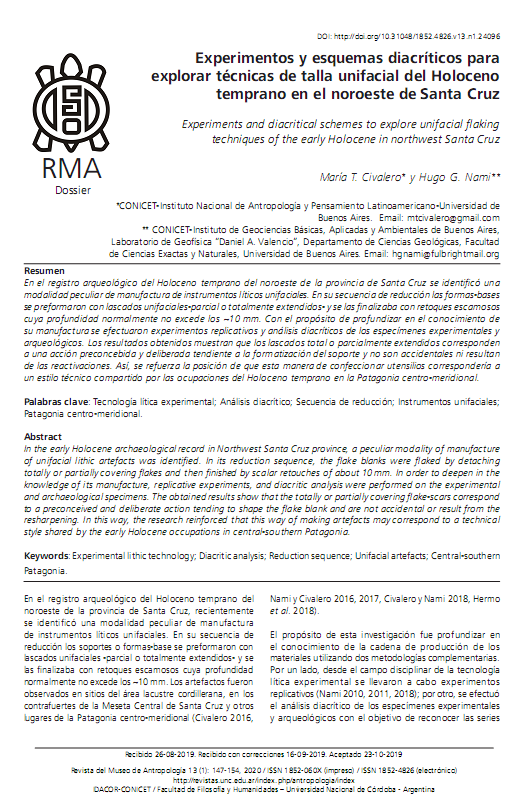Experiments and diacritical schemes to explore unifacial flaking techniques of the early Holocene in northwest Santa Cruz
DOI:
https://doi.org/10.31048/1852.4826.v13.n1.24096Keywords:
Experimental lithic technology, Diacritic analysis, Reduction sequence, Unifacial artefacts, Central-southern PatagoniaAbstract
In the early Holocene archaeological record in Northwest Santa Cruz province, a peculiar modality of manufacture of unifacial lithic artefacts was identified. In its reduction sequence, the flake blanks were flaked by detaching totally or partially covering flakes and then finished by scalar retouches of about 10 mm. In order to deepen in the knowledge of its manufacture, replicative experiments, and diacritic analysis were performed on the experimental and archaeological specimens. The obtained results show that the totally or partially covering flake-scars correspond to a preconceived and deliberate action tending to shape the flake blank and are not accidental or result from the resharpening. In this way, the research reinforced that this way of making artefacts may correspond to a technical style shared by the early Holocene occupations in central-southern Patagonia.
Downloads
References
Baena Preysler, J. y Cuartero, F. (2006). Más allá de la tipología lítica: Lectura diacrítica y experimentación como claves para la reconstrucción del proceso tecnológico.José Manuel Maillo y Enrique Baquedano (Eds.) Miscelánea en homenaje a Victoria Cabrera. Zona Arqueológica 7(1): 144-161.
Baena Preysler, J. y Carrión Santafé, E. (2010). Experimental Approach to the Function and Technology of Quina Side-Scrapers. En H. G. Nami (Ed.), Experiment and Interpretation of Traditional Technologies: Essays in Honor of Errett Callahan (pp. 171-202). Buenos Aires: Ediciones de ArqueologíaContemporánea.
Callahan, E. (1979). The Basics of Biface Knapping in the Eastern Fluted Point Tradition. A Manual for Flintknappers and Lithic Analysts.Archaeology of Eastern North America, 7: 1-180.
Callahan, E. (1982). An Interview with Flintknapper Jacques Pelegrin. Contract Abstracts 3(1): 62-70.
Civalero, M. T. (2016). Propuesta metodológica para el análisis del material lítico del sitio Playa Cisnes 2, provincia de Santa Cruz, Patagonia argentina. En F. Mena (Ed.) Arqueología de la Patagonia: de mar a mar (pp. 235-244). Coyhaique: Ediciones CIEP/Ñire Negro Ediciones.
deMortillet, A. (1910). Le Travail de la Pierre auxtempspréhistoriques (Premièrepartie). Revue de l’Ecoled’Anthropologie de Paris, 20, 1-21.
Dibble, H. L. (1995). Middle Paleolithic Scraper Reduction: Background, Clarification, and Review of the Evidence to Date. Journal of Archaeological Method and Theory, 2: 299-368.
Flenniken, J. J. (1984). The Past, Present, and Future of Flintknapping: An Anthropological Perspective.Annual Review of Anthropology, 13(1), 187-203.
Hermo D., Mosquera,B., Vargas Gariglio, J. y Pérez, A. (2018). Indicadores tecnológicos de colonización en contextos de superficie del Macizo del Deseado (Santa Cruz, Argentina). Libro de Resúmenes del 9 Simposio Internacional el Hombre Temprano en América. La gente y sus lugares (pp. 66-67). Necochea.
Nami, H.G. (1984). La tecnología lítica y una nueva propuesta nomenclatoria. Arqueología Contemporánea I (2): 21-25.
Nami, H. G. (2002). Comentario al libro “Tecnología Lítica Experimental. Introducción a la Talla de Utillaje Prehistórico” por J. Baena Preysler, BAR International Series 721, Oxford, 1998. Trabajos de Prehistoria 59 (1): 182-185, Madrid.
Nami, H. G. (2010). Theoretical Reflectionson Experimental Archaeology and Lithic Technology. En Nami, H. G. (Ed.) Experiments and Interpretation of Traditional Technologies: Essays in Honor of Errett Callahan (pp.91–168). Ediciones de Arqueología Contemporánea. Buenos Aires.
Nami, H. G. (2011). Fundamentos teóricos y epistemológicos sobre arqueología y tecnología lítica experimental. Arqueología Rosarina Hoy 3(1): 75-98.
Nami, H. G. (2015). Experimental Observations on some Non-Optimal Materials from Southern South America. Lithic Technology, 40: 128-146.
Nami, H. G. (2018). Theoretical and Epistemological Thoughts on Archaeology and Experimental Lithic Technology. Journal of Research in Philosophy and History 1(2): 139-165.
Nami, H. G. y Civalero, M. T. (2016). Experimentos para explorar la manufactura de instrumentos unifaciales peculiares del noroeste de la provincia de Santa Cruz. Libro de Actas del XIX Congreso Nacional de Arqueología Argentina. Serie Monográfica y Didáctica, 54: 769-772. San Miguel de Tucumán.
Nami, H. G. y Civalero, M. T. (2017). Distinctive Unifacial Technology during the Early Holocene in Southern South America. Archaeological Discovery 5: 101–115.
Sacchi M., Bozzuto, D., Horta, L.,Fernández, N., De Nigris, M.,Civalero, M.T., Aschero, C. (2016). Dataciones y circulación humana: influencia de las fluctuaciones del sistema lacustre Pueyrredón-Posadas durante el Holoceno. Andes (Salta) (27) 27. CEPIHA (Centro Promocional de Investigaciones en Historia y Antropología).
Viana Sibeli, A. y Borges, C. T. (2014). Compreendendo ferramentas líticas a partir das persistências e das variabilidades técnicas. Estudo de caso dos sítios GO-CP-17 e MT-SL-31, Região Centro Oeste do Brasil. En (Farías, M. &Lourdeau, A. Eds.) Peuplement etModalitésd’Occupation de l’Amérique du Sud: l’Apport de la Technologie Lithique (pp.65–95). Prigonrieux: @rchéo-éditions.com and Impr. Copy-média.

Downloads
Published
Issue
Section
License
Those authors who have publications with this Journalaccept the following terms:
a. Authors will retain their copyrights and guarantee the journal the right of first publication of their work, which will be simultaneously subject to the Creative Commons Attribution License (Licencia de reconocimiento de Creative Commons) that allows third parties to share the work as long as its author and his first publication in this journal.
b. Authors may adopt other non-exclusive licensing agreements for the distribution of the version of the published work (eg, deposit it in an institutional electronic file or publish it in a monographic volume) provided that the initial publication in this journal is indicated.
c. Authors are allowed and recommended to disseminate their work on the Internet (eg in institutional telematic archives or on their website) before and during the submission process, which can lead to interesting exchanges and increase citations of the published work. (See The Effect of Open Access - El efecto del acceso abierto)











